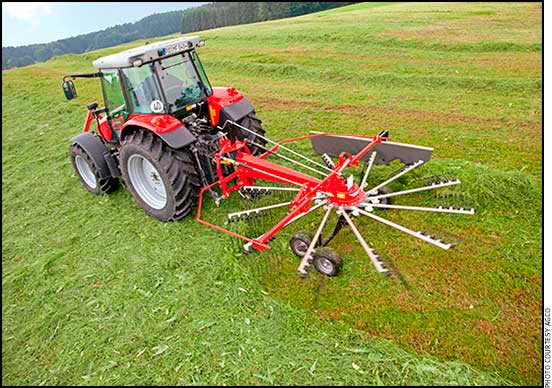
A good raking job can be the difference between quality hay and uneven bales that are subject to spoilage, reminds Hesston’s Dean Morrell.
Raking Tips for Superior Hay
Whether you are cutting, conditioning, raking or baling, all steps in the process of making high-quality hay require attention to detail. Any slipups along the way can compromise the end result. Raking is perhaps the most critical step in the process, as more leaf loss can be caused by improper raking than by any other step in the harvest process.
“A good job of raking can make baling high-quality hay relatively easy,” says Dean Morrell, Agco hay and forage product marketing manager for Hesston by Massey Ferguson® and a 35-year veteran of the quality hay business. “On the other hand, if raking is done poorly, the result can be poor-quality bales that are subject to spoilage.” Morrell reminds producers to avoid raking alfalfa or clover when the forage moisture is less than 35%-40% to prevent the loss of nutrient-dense leaves. Leaves contain two-thirds of the protein and 75% of the total digestible nutrients (TDN) in alfalfa hay.
Raking can’t be avoided, because this process gathers a mowed swath into a windrow or gathers two or more windrows into one for more efficient baling. By creating windrows that are uniform in width and in the amount of hay they contain, producers help ensure bales are consistent in shape and density. Also, by creating windrows as large as possible to meet the baler capacity, the amount of loss during the baling process can be minimized when hay is at its driest and most subject to leaf loss from handling.
In addition to proper timing and technique, properly setting the rake ensures good results. Overall, wheel rakes are simplest to set, but rotary rakes, which have more adjustments, often provide superior results, with less dirt contamination in the hay and, therefore, less ash, which reduces forage digestibility. Check the operator’s manuals for full details on best practices for setting and operating your style of rake for superior hay production.
Here are several tips on how to set and operate rakes. Except where indicated, tips are for rotary rakes:
- Set rake tines of rotary rakes to skim just above the ground, so they don’t dig up dirt, contaminating the hay and wearing down tines unnecessarily. Set wheel rakes to have as little contact with the ground as possible.
- Make sure rotary rake bogey wheels beneath the rotor are level. The rotor should have one-half to 1 inch of ground clearance on all sides at all times.
- Set the tine arm release based on crop conditions and the size windrow you desire. A dry, fluffy crop requires an earlier release setting. For a heavy, wet crop, use a later release setting.
- For maximum drying, set the windrow as wide as possible.
- If the rake is PTO-driven, synchronize the field speed and PTO speed for a gentle lifting and turning action. This helps avoid aggressive handling that can cause excessive leaf loss.
- Operate the rake at a consistent speed to create an even windrow for uniform drying and fewer slugs of wet, bunched hay, thus allowing hay to be fed smoothly and evenly into the baler for superior baler performance. The end result will be high-quality bales and reduced risk of crop spoilage.
- Stay up to date on regular maintenance to ensure peak machine performance, including daily greasing of pivot points and hinges. Tighten bolts and replace broken or worn tines. Check tire inflation regularly.
- Be sure to visit your local dealer to stock up on replacement tines and basket and rake-wheel bearings before the season starts to minimize downtime from common breakdowns. Dealers often have a list of parts recommended for on-farm stocking and may offer preseason discounts for parts purchases.
Editor’s Note: This article was provided by Agco. For more information about Hesston by Massey Ferguson products or to find a dealer near you, visit http://www.hesston.com.






